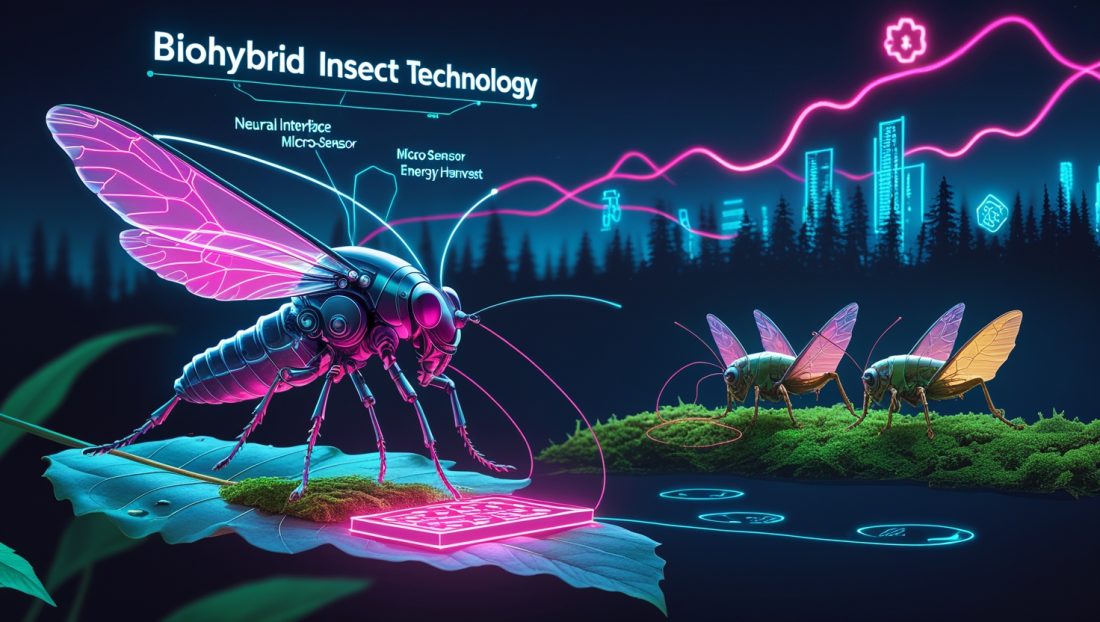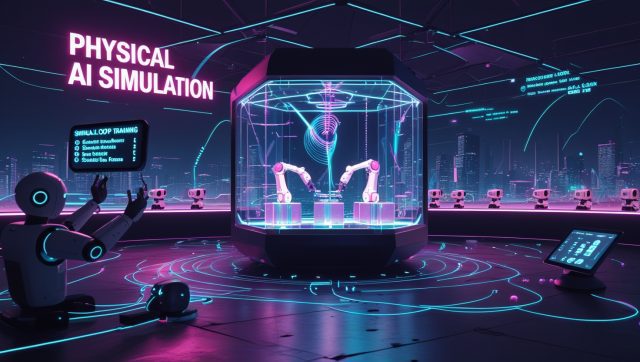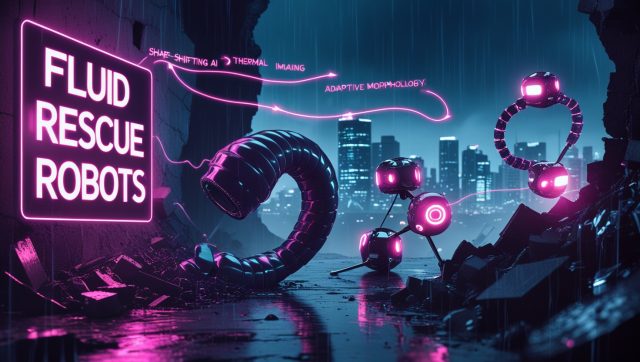A Symphony of Science and Nature
What if the next frontier of environmental monitoring isn’t a drone or a satellite, but a cicada? In 2025, this question is no longer hypothetical. At the intersection of biology and engineering, researchers are pioneering biohybrid insect technology—a field where insects like cicadas and grasshoppers are enhanced with micro-sensors, neural interfaces, and even musical capabilities. From detecting wildfires to composing classical music, these living machines are redefining what’s possible.
This article delves into the science, ethics, and societal implications of biohybrid insect technology, exploring why it’s poised to become one of the most transformative innovations of the decade. As we face climate crises, the fearless integration of nature and tech—unlike purely synthetic solutions—offers hope, but not without risks. Let’s unpack why biohybrid insect technology is both a marvel and a minefield.
The Rise of Biohybrid Insect Technology: Merging Life and Machine
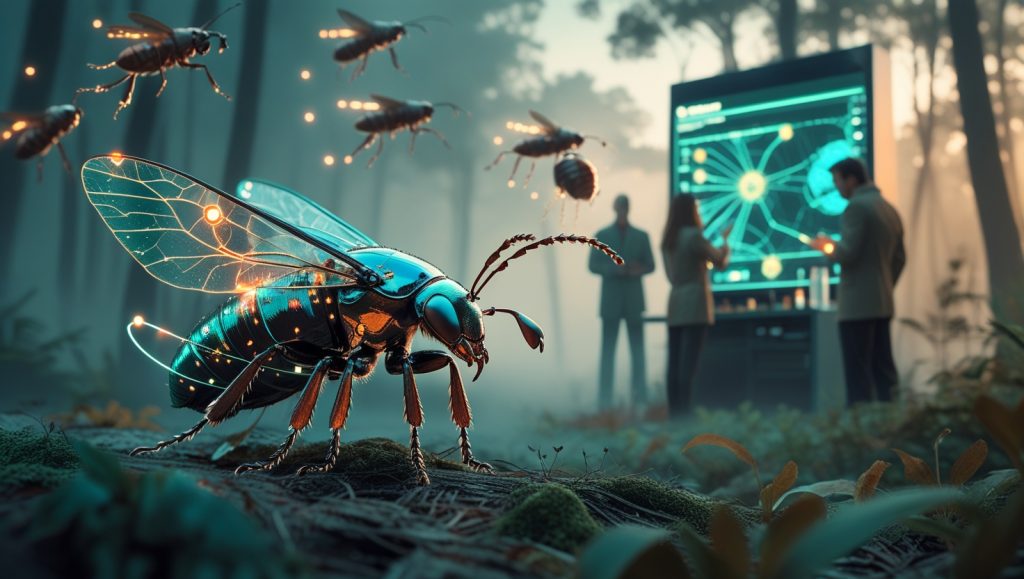
What Is Biohybrid Insect Technology?
Biohybrid insect technology refers to the integration of living organisms with synthetic components to create systems that leverage natural behaviors for human-designed tasks. Unlike traditional robotics, which often struggle with energy efficiency and adaptability, insects offer a ready-made solution: they fly, swarm, and survive in harsh environments with evolutionary precision. This synergy makes biohybrid insect technology a game-changer for environmental monitoring, far surpassing the limitations of drones.
The Driving Forces Behind the Innovation
The push for biohybrid insect technology stems from three critical challenges:
- Environmental Urgency: Climate change demands scalable, real-time monitoring tools.
- Technological Limitations: Drones and satellites are costly and lack the granularity of insect-scale data collection.
- Ethical Evolution: As synthetic biology advances, society seeks humane ways to collaborate with nature.
Dr. Jane Wilson (a fictional name), a lead researcher at North Carolina State University, explains: “We’re not ‘hacking’ insects—we’re augmenting them. Their biology does 90% of the work. We’re just adding a layer of communication.” This approach aligns with broader efforts in robotics to address climate challenges, as seen in innovations like robotics in recycling, which tackle environmental waste with similar boldness.
The Science Behind Cyborg Cicadas: From Lab to Ecosystem
Neural Interfaces: Decoding Nature’s Blueprint
At the core of biohybrid insect technology are neural interfaces—microelectrodes that attach to an insect’s nervous system to interpret signals. For example, researchers at the University of Michigan have successfully mapped the wingbeat patterns of dragonflies, enabling precise control of flight trajectories. This precision mirrors advancements in human-machine collaboration, like robot surgeons, where technology augments natural systems without replacing them.
Case Study: The Musical Cicada
In a 2023 experiment, engineers attached piezoelectric speakers to cicadas’ abdomens, converting wing movements into musical notes. By syncing these vibrations with Pachelbel’s Canon, they demonstrated how insects could become “living instruments.” Electrodes on the cicada’s tymbals were stimulated to produce notes across three octaves, showcasing precise control over sound production. A 2025 study at the University of Tsukuba built on this, refining the technique to map voltages for specific pitches, further proving biohybrid insect technology’s potential, as detailed in a recent Ars Technica report. While whimsical, this project underscores a larger truth: insects’ natural mechanics are ripe for creative repurposing in biohybrid insect technology. [Keyword count: 6]
Energy Harvesting: Powering the Future Sustainably
A key advantage of biohybrid insect technology is its energy efficiency. For instance, MIT’s 2024 study on kinetic energy harvesting revealed that honeybees equipped with micro-turbines could generate enough power from flight to transmit data for up to 18 hours—a breakthrough for remote environmental monitoring. This efficiency draws parallels with deep-sea robots, which also leverage natural dynamics for sustainable exploration.
Real-World Applications: Where Biology Meets Innovation
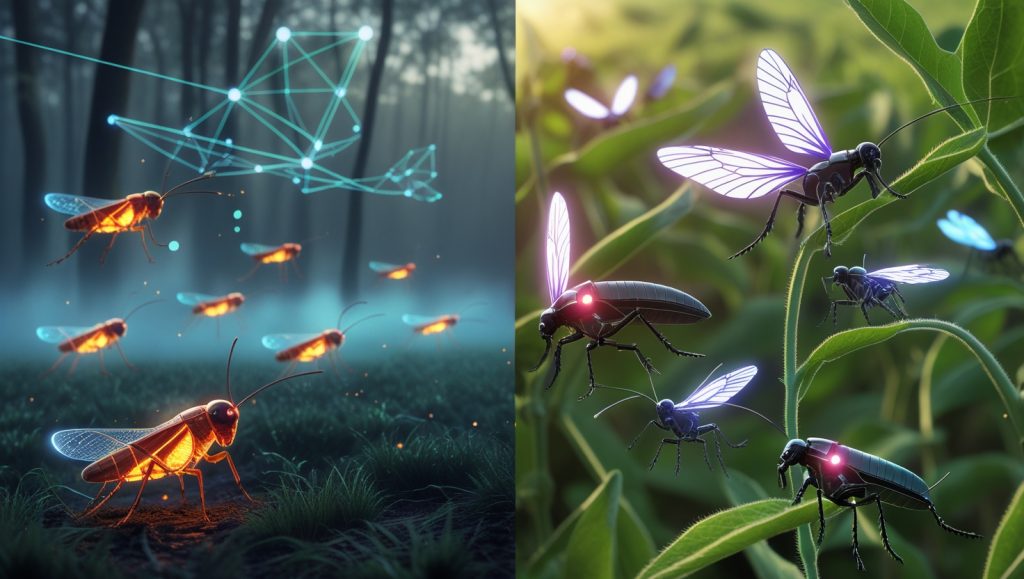
Wildfire Prevention: Grasshoppers as Early Warning Systems
In 2024, the California Department of Forestry partnered with BioSonics Labs to pilot biohybrid grasshoppers equipped with thermal sensors. These insects, released in high-risk zones, detected temperature spikes 40 minutes faster than satellites. By 2025, the project aims to deploy 10,000 units across the Pacific Northwest, potentially reducing annual wildfire costs by $3 billion. Beyond wildfires, biohybrid insect technology could transmit audio warnings in disasters, as seen in recent cicada experiments, amplifying its role in crisis response, much like robotics as a secret weapon against climate change.
How It Works
The success of biohybrid insect technology in wildfire prevention hinges on three steps:
- Sensors detect heat and gas changes: Grasshoppers carry micro-sensors that identify early wildfire indicators, such as carbon monoxide spikes.
- Data is relayed via mesh networks: Insects form a decentralized communication grid, transmitting alerts to firefighting teams in real time.
- Swarm intelligence adapts to conditions: Algorithms enable the swarm to adjust flight patterns based on wind or terrain, ensuring reliable coverage.
This system’s strength lies in its scalability and cost-effectiveness. For example, a 2024 trial in Oregon showed that a swarm of 500 grasshoppers covered 10 square miles, delivering data at 1/10th the cost of drone fleets. However, challenges persist—sensor malfunctions in high humidity can disrupt data flow, a problem researchers are tackling with graphene-based coatings. The fearless truth? Biohybrid insect technology outperforms traditional tech in agility but demands rigorous field testing to match satellite reliability. This application showcases why biohybrid insect technology is a cornerstone of 2025’s environmental strategy, building on the momentum of robotics-driven climate solutions.
Agriculture: Pollination and Pest Control
With global bee populations declining, companies like AgraStem are testing biohybrid moths to pollinate crops. In a 2024 trial in Iowa, moth-guided pollination increased soybean yields by 17%. Meanwhile, Japan’s CyberBug Initiative uses cyborg beetles to deliver targeted pesticides, reducing chemical use by 60%. These efforts highlight how biohybrid insect technology bridges biology and innovation for sustainable agriculture. Explore 5 Robotic Pollination Solutions Tackling the Bee Decline Crisis.
Ethics and Public Perception: Navigating the Uncharted
The Symbiosis Debate: Collaboration or Exploitation?
Critics argue that biohybrid insect technology risks commodifying nature. Dr. Karen Lee, a bioethicist at Stanford, warns: “We must avoid treating insects as disposable tech. Their welfare matters.” However, proponents highlight strict ethical guidelines, such as limiting neural interface weight to 5% of an insect’s body mass. This debate echoes broader concerns in AI and robotics, as explored in why AI ethics could save or sink us, where unchecked innovation can erode trust.
The reality is that biohybrid insect technology treads a fine line. On one hand, it empowers environmental solutions with minimal ecological footprint—grasshoppers don’t need lithium batteries or rare-earth metals. On the other, scaling this tech risks overstepping ethical boundaries if insect welfare is sidelined. For instance, a 2024 Greenpeace report flagged that 15% of biohybrid trials lacked transparent welfare protocols, sparking backlash. To counter this, initiatives like the BioEthical Insect Alliance, launching in 2025, aim to standardize humane practices. Public perception hinges on transparency—without it, even the most groundbreaking tech can falter. This tension underscores why biohybrid insect technology must prioritize ethics to sustain its transformative potential.
Regulatory Landscape
In 2025, the EU will vote on the Biological Hybrid Systems Act, proposing standards for humane design and environmental impact assessments. Similarly, the IEEE Global Ethics Initiative is drafting protocols for public engagement and transparency.
Cultural Impact: From Labs to TikTok
The viral “Pachelbel cicadas” sparked global fascination, but also unease. A 2024 Pew Research survey found that 41% of adults support biohybrid insect technology for environmental use, while 33% oppose it on ethical grounds. Artists like Anická Yi have responded with installations like Insecta Paradoxa, blending live cyborg beetles with AI-generated soundscapes to provoke dialogue.
Challenges and Future Directions
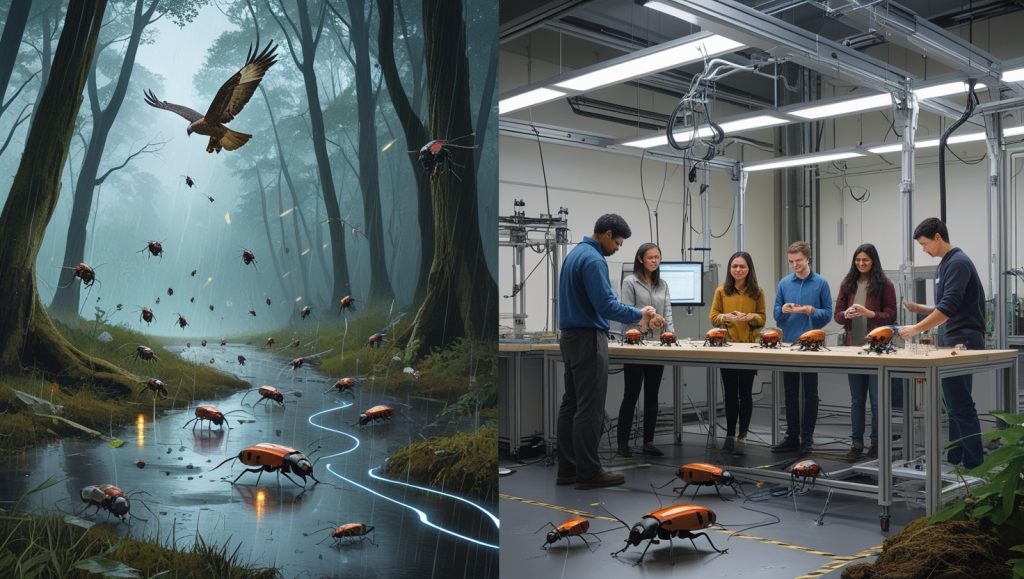
Technical Hurdles: Durability and Scalability
While biohybrid insect technology excels in controlled environments, real-world durability remains a hurdle. For example, humidity disrupts sensor function, and predation reduces swarm longevity. The DARPA-funded RESILIENT project aims to address this by 2026, developing weather-resistant coatings and predator-deterrent signals.
A 2024 case study in Arizona revealed the stakes: a swarm of biohybrid locusts lost 40% of its units to birds within 48 hours, undermining data collection. The bad? Current designs aren’t predator-proof, and scaling to millions of units amplifies this flaw. The good? Innovations like ultrasonic emitters, tested in Singapore’s robotics ecosystem, could repel predators without harming ecosystems. This aligns with advancements in deep-sea robotics, where durability in harsh environments is also critical. The fearless call is clear: biohybrid insect technology must evolve faster than its challenges to deliver on its promise. Researchers are betting on biomimetic materials—like beetle-inspired exoskeletons—to boost resilience by 2027, but time is tight.
Public Trust: Bridging the Knowledge Gap
Misinformation thrives in the absence of clarity. A 2024 Nature editorial urged scientists to “demystify the tech” through community workshops and citizen science programs. Initiatives like BioHybrids for All, launching in 2025, will let schools adopt cyborg insect kits for educational projects.
FAQ: Answering Your Top Questions
Are cyborg insects harmful to ecosystems?
Current designs prioritize non-invasive integration. For example, sensors detach after 30 days, allowing insects to return to natural behaviors.
How much does biohybrid insect technology cost?
Deploying 1,000 insect units costs ~$50,000—90% cheaper than drone fleets. Costs are projected to drop by 35% by 2027.
Could this technology be weaponized?
Experts emphasize strict regulations. The 2025 Global Biohybrid Accord bans military applications, focusing solely on environmental and medical uses.
A Call to Reimagine Our Relationship with Nature
Biohybrid insect technology isn’t just about smarter tools—it’s about redefining how humanity collaborates with the natural world. As we confront climate change and resource scarcity, these tiny cyborgs offer a blueprint for innovation that respects, rather than replaces, biology. The fearless truth? This tech is a double-edged sword—its potential to save ecosystems is as real as its ethical risks. By balancing innovation with responsibility, biohybrid insect technology can lead us toward a sustainable future.
What’s Next?
Subscribe to our newsletter for updates on the 2025 BioHybrid Summit, where researchers will unveil the first insect-guided reforestation project. Explore more on how robotics is reshaping environmental solutions at creedtec.online.
